As much as I love the traditional Chinese scallion pancakes, I have to admit, I love Korean pancakes (pa jeon or pajung or whatever) even more. I love how they're so moist on the inside but still super crispy on the outside. And even better, it's a great way to get rid of leftovers, which I really appreciate because some weeks I have a lot of leftover hot pot ingredients that I need to get rid of.
The only problem is, every time I ask a Korean how to make this from scratch, they just tell me that their moms make it from the mix. Seriously? I can't think of a single thing that my mom makes that uses a mix! Fortunately, I live close enough to several Korean grocery stores and can pick up the mix, which does deliver an almost no-fail pancake every time.
Looking at the list of ingredients, though (wheat flour, sugar, salt, baking powder, MSG), it just seems incredible that it can't be replicated from scratch. I've tried both David Lebovitz's and the New York Times versions, but they both couldn't compare to the mix. The last week I saw this post on The Kitchn. Could it be that I finally found a recipe that could replicate or even supersede the mix?
It seemed likely. Not only did this recipe include rice flour, which I always assumed was used in pa jeon because of the light, moist texture, but it also used seltzer water to add airiness to the batter. So I decided to have a side-by-side comparison of the two pancakes. The ground rules:
- I used the same filling for both: scallions, diced and sweated bok choy stems, sliced fish cake, marinated and sauteed beef, sliced and sauteed Chinese sausage.
- I would use the same non-stick pan and the same amount of oil (exactly 2 tablespoons of canola) for each.
- I would cook both the same way: 4 minutes on each side at medium heat.
Homemade Korean Pancake from Scratch (based on this recipe)
makes 1 big pancake
1.2 cup all purpose flour
1/2 cup rice flour
1 egg, lightly beaten
3/4 cups cold unflavored seltzer water
1/2 tablespoon canola oil, plus extra for the pan
makes 1 big pancake
1.2 cup all purpose flour
1/2 cup rice flour
1 egg, lightly beaten
3/4 cups cold unflavored seltzer water
1/2 tablespoon canola oil, plus extra for the pan
In a large bowl, gently mix flours, eggs, seltzer, and oil until smooth. Let rest a few minutes and then stir in filling, tossing to coat.
Heat a large frying pan over medium heat and coat with 2 tablespoons of canola oil. When pan is hot, add batter and spread out so it's no more than a half-inch thick. Turn heat down to medium-low.
Cook about 4 minutes, flipping when pancake no longer resists, then cook about 4 minutes on the other side. Pancake should be crispy and brown, with no liquid inside.
As you can see from the pictures, I had a hard time flipping the pancake over in one piece, but that's due to user error and not one of the criteria for this contest.
Korean Pancake Mix (from the back of the bag)
makes 1 big pancake
1 cup Korean pancake mix
3/4 cups water
In a large bowl, mix mix and water until there are no lumps. Add filling, mixing to coat.
makes 1 big pancake
1 cup Korean pancake mix
3/4 cups water
In a large bowl, mix mix and water until there are no lumps. Add filling, mixing to coat.
Heat a large frying pan over medium heat and coat with 2 tablespoons of canola oil. When pan is hot, add batter and spread out so it's no more than a half-inch thick. Turn heat down to medium-low.
Cook about 4 minutes, flipping when pancake no longer resists, then cook about 4 minutes on the other side.
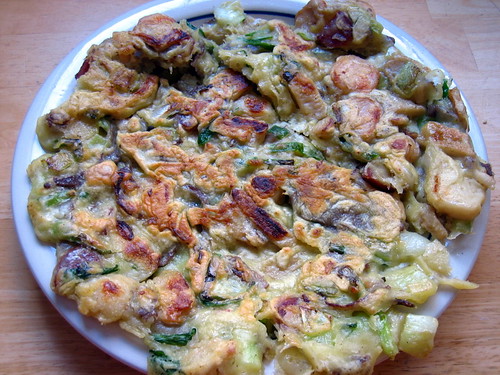
The batter for the mix version was definitely a lot drier due to the fact that there was no egg or oil added, and you definitely had to "push" the batter around in the pan to get it to an even thickness. And once again, I tore the pancake in two trying to flip it over. So I guess both versions are even there. =P
For the dipping sauce, I mixed equal portions of rice wine vinegar and aged soy sauce and added a splash of sesame oil and a pinch of sugar.
For the dipping sauce, I mixed equal portions of rice wine vinegar and aged soy sauce and added a splash of sesame oil and a pinch of sugar.
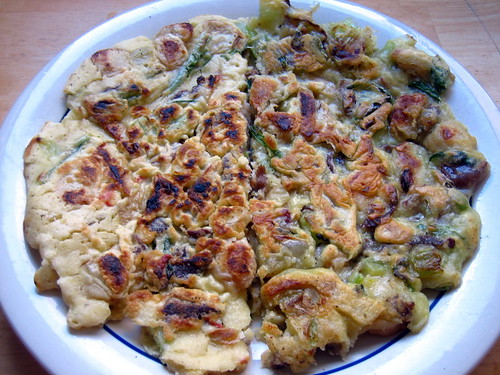
Side-by-Side
Comparing the two, all testers found that one was definitely more moist and generally had a preferable texture (less dense) to the other. Otherwise, there didn't seem to be too much of a difference in flavor, although Jenny did mention that because we were using a dipping sauce, just about anything would've tasted the same.
Can you guess which version won the taste test? Answer in the next post.
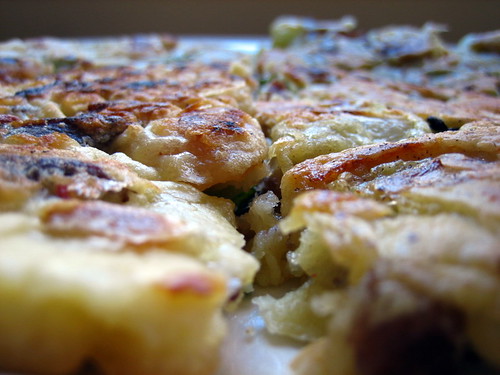



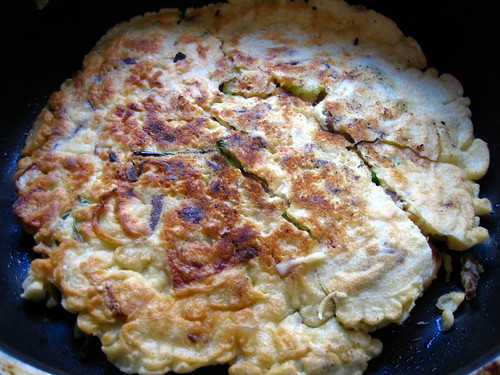

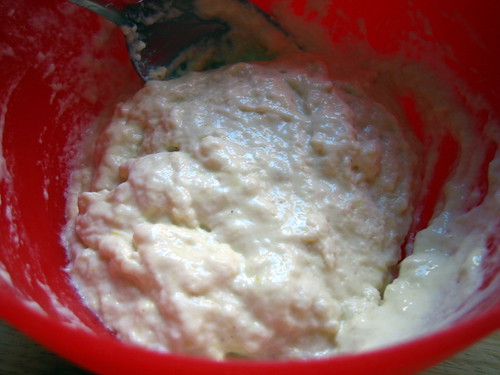
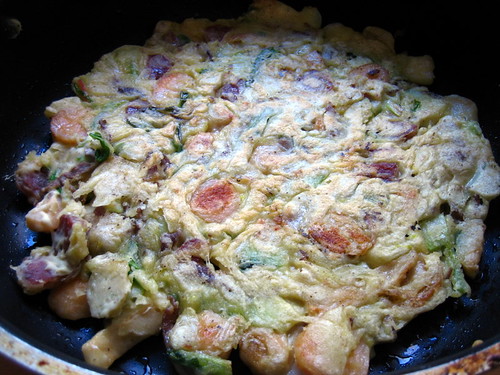





I love your blog. There are hardly any chinese blogs out there and its fascinating to see food recipes for stuff my mom made growing up. It's great.
ReplyDeletei bet the mix still won. i've heard the same thing about the mix being the preferred way of making pajeon. though i've also seen ppl make pajeon over a fire on a cast iron skillet. oooh. :)
ReplyDeleteI found your post through foodgawker, and just as an encouragement to keep trying to make it from scratch, my grandma never ever uses the mix. Luckily, I've watched her make all kinds of "jeon (pancake)" types from just regular old flour. The only problem is that the recipes are never written down and the ratios of flour:salt:water are never measured out as of yet. (I promised myself that I'll get to it sooner than later).
ReplyDeleteOne tip, however, that many Korean moms know when making pancakes/fried stuff is to use really cold water (or even let the ice cubes melt in the flour+salt mixture) to make the outside coating really crispy. The contrast between cold batter and sizzling oil does the trick, I was told. Ja-yo!
The cold batter trick works. I just tried it, and they came out much crispier. WOW! I can't wait to try it with rice flour next time! I think that there is also an issue with the egg, and that crispy pancakes don't use it.
DeleteI stumbled upon your blog while looking for a recipe for korean pancackes...and wow, loved your throwdown! My korean mommy also recommends buying the mix but i'm going for the homemade version tonight. Looking forward to reading more of your blog soon. Thanks from Chicago!
ReplyDeleteI came across your blog when searching for a pajeon recipe.
ReplyDeleteI made some with seafood and some with meat for my family and they were delicious. =D
But I bought the mix too.^^